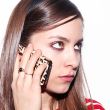We love beauty products, and we love experimenting, but we understand not having time to wile away the hours at your nearest makeup counter. Most of you just want to know what’s good, why, and how to get it. Anyway, a few weeks ago, we got all makeup-theory and weighed in on primers, and a whole bunch of you took to the comments/our e-mail inboxes to ask about foundations (e.g., “Pleeeease, ITG, do a round up on foundations!!!”). We had a better idea— we enlisted writer Molly Young to investigate every brand and type of foundation under the sun (literally, she assembled dozens) and play guinea pig. The result: A 3-day foundation extravaganza, which we're calling Foundation Week (like Shark Week). First up: What is foundation and why do we use it?
Let’s not kid ourselves. The history of makeup is the history of women eating poison, rubbing poison on their faces, rinsing their hair with poison and then—when the tidal wave of poison finally catches up with them—applying more poison to keep up appearances. Sumerian queens mixed lead with red dust and called it lipstick. 16th-century Venetian ladies coated their hair in horse urine for blondness. (I bet the results were still better than Sun-In!!) Victorian lotions dripped with arsenic. Depilatory formulas contained thallium, which would be amazing for removing unwanted hair if it wasn't also used to kill rats. A 1922 book by a chemist named George William Askinson contains a recipe for “Freckle Milk' that features mercury as its main ingredient; the doctor thoughtfully advises readers to handle mercury “with the greatest care!”
(But doctor, those silver pellets are so fun to play with!)
We’re lucky to live in an era where safety in makeup is a given. Safety, however, doesn’t mean quality, or that it’s any easier to locate the right makeup. Finding a color match in the foundation field is especially tough, and the market is overstuffed. If you do happen upon the right shade, the coverage — heavy and opaque? light and sheer? — is apt to be wrong. If you find the right coverage, the finish will be weird. An hour at the beauty counter is enough to make a person cry oily beige tears.
The best thing about today’s makeup, aside from the fact that it won’t cause nerve damage, is the way that products are named. The conventions are extremely straightforward: eyeliner is for making lines around your eyes. Lipstick is a stick that you put on your lips. Concealer is to conceal horrible things. Nothing fits the rule as well as foundation, which is exactly that: the hidden infrastructure of your makeup.
Do you wear foundation? I do. I’m naturally pale, with ruddy cheeks, visible pores, and a yellowish donut of skin around my mouth; I need foundation primarily to even everything out. I need it secondarily to carpet over blemishes and protect against New York City’s ambient filth.
Because we naturally assume that what is true for us is true for everyone else, I’d always assumed that my friends wore foundation. Uh, wrong! After quizzing thirty of them about what brands they wore, I was dismayed to find that few of my friends wore any kind of foundation at all. (Some wear tinted moisturizer.) Here, I Excel-charted the results to show you:

Sigh.
I know my friends meant no harm in answering honestly, but, to me, “I don’t wear foundation” has always translated as “I don't need foundation!” which turns into feelings on my part of sadness and embarrassment about needing foundation. Going without it is the beauty equivalent of wearing tight white jeans: a small number of women can pull them off…and I am not one of them. (Miranda Kerr is.)
Luckily, there is dark denim and a variety of products for the rest of us to pour all over our faces, like gravy over mashed potatoes. You can even put foundation on your eyelids, like Grace Coddington! (who does it to achieve a “pale, bald, Renaissance look,” as she explains in her memoir, Grace). Most women, however, use foundation for its stated purpose—and here is where my mystification begins. What kind is the best—liquid, mousse, spray, powder? How are you supposed to apply it? Why is it so hard to find the right color?
In order to answer these bedrock foundation questions, I quizzed makeup artists, Skyped with a foundation “expert” (yes, such a thing exists), stained collars, and tried every formula I could get my hands on. I even Googled “skin” (not recommended). I listened, took notes, went through a malt liquor-sized bottle of Bioderma makeup remover, and compiled my findings for ITG.
First, the fundamental observations:
Perfect skin is a status symbol
Wealthy people and celebrities have much better skin than non-wealthy, non-famous people. Not always, but in general. This is unfair and upsetting, but it makes sense—having access to facials, expensive skin products, and resourceful dermatologists will make anybody’s skin better. Based on observations, I can state that having perfect skin, in New York City, is the second most conspicuous status symbol, after walking around with an extremely large dog (which indicates a correspondingly enormous apartment).
Beige
The beauty industry should be more inventive with color labeling. Why are all my foundation shades “beige”? Nobody wants beige skin. Beige is for area rugs. What about Tawny Sawdust? Buttered Chipmunk? Ikea Bookshelf? All of these describe my skin tone more evocatively and memorably than “beige.”
iPhones and foundation are natural enemies
If you wear foundation, you are familiar with the skin-colored fuzz that sticks to your screen after a phone conversation. Disgusting. Can’t be prevented. [See photo 4.]
Trust not in waffle-face
Don't trust someone who has bad foundation to advise you on foundation. This is obvious in theory but counterintuitive when, for example, you stroll up to the YSL counter and find a beautiful employee who looks like she face-planted in waffle batter. Walk away.
Clarins has the best packaging
The foundation comes in a geometric golden container with a hidden compartment. It looks like an Egyptian treasure.
Primer
Has never made a difference for me.
The paradox of heavy coverage
If you wear matte heavy-coverage foundation in your everyday life, you’ll look like Tom Hanks in Polar Express. If you wear matte heavy-coverage on camera, you’ll look really nice. (See: the Kardashian women.)
The biggest difference between drugstore foundation and luxury foundation
…is that luxury foundation lasts longer.
Color is all
At the end of the day, it’s all about color—the shade. That’s it. That’s all that matters. Unless your skin is freakishly sensitive to certain ingredients, there’s no reason to avoid a certain brand if they make the right color for you.
Check back tomorrow for Foundation Week, Day 2: The Good Ones, the Bad, and the Ugly. (Or, The Results Are In!)
Molly Young photographed by Emily Weiss in New York. If you're looking for more Molly, read her Top Shelf and follow her on Twitter @magicmolly.








